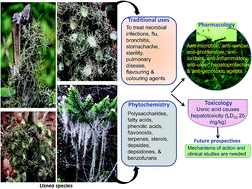The genus Usnea: a potent phytomedicine with multifarious ethnobotany, phytochemistry and pharmacology
Abstract
The genus Usnea Adans. (Parmeliaceae; lichenized Ascomycetes) is a typical group of mostly pale grayish-green fruticoselichens that grow as leafless mini-shrubs. More than 360 species of Usnea are known in the world. Usnea has long been thought to have treat various illnesses in addition to its historical use as dyes, cosmetics, preservatives, and deodorants, particularly in eastern countries such as China, Japan, Taiwan, India and Europe. The current review focuses on the traditional uses and phytochemistry aspects of different Usnea species, and discusses the pharmacological findings and toxicology of their extracts and isolated compounds. The available compilation of data will provide a new base for future perspectives and highlight the need for further studies of this potent herbal source to harvest more beneficial therapeutic drugs. Nineteen species of the genus Usnea are found to be important folk medicines all over the world. It is evident from the comparative analysis of the searched literature that the genus Usnea has been used for various purposes for centuries and its long and traditional medicinal history was well documented in the past. As per ancient records and recent scientific literature, the species of genus Usnea have been used as promising traditional medicines, exerting an array of therapeutic properties to relieve sore throats, bronchitis, cold, flu, infection, and indigestion. Phytochemical analysis confirms the general presence of a wide range of metabolites, polysaccharides, fatty acids, phenolic acids, flavonoids, terpenes, sterols, depsides, depsidones, and benzofurans. As specific constituents, usnic acid, polyphenols, and depsides have been considered as main efficacy component for antibacterial and antifungal activities. In addition, pharmacological analysis also revealed that other pure compounds and crude extracts of Usnea species prove to be significant anti-cancer, anti-proliferative, anti-oxidant, anti-viral, anti-inflammatory, anti-ulcer, hepatoprotective, and anti-genotoxic agents. However, there is a need for more precise investigations to examine the clinical value of both isolated pure compounds and crude extracts and to elucidate their mechanisms of action. Apart from clinical validation and elucidation of their mechanism of action, biosafety studies of the compounds are also important to legitimately use the potential bioactive compounds for the further development of future lead drugs.


 Please wait while we load your content...
Please wait while we load your content...